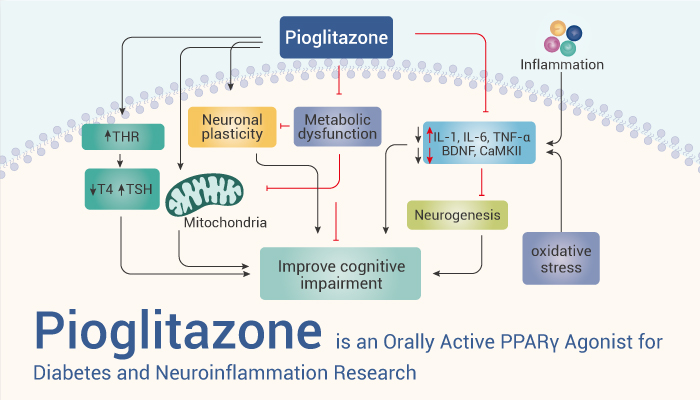PPARγ is a nuclear receptor involved in lipid metabolism and insulin sensitivity. PPARγ can bind to specific sequences in DNA to regulate the transcription of genes related to these sequences, including obesity, diabetes, cardiovascular disease, and certain types of cancer. Meanwhile, it plays a key role in regulating lipid and glucose metabolism, cell proliferation and differentiation, and inflammatory responses. PPARγ has also been found to play an important role in regulating immune responses and inflammation, especially neuroinflammation. Now, here is a PPARγ agonist, Pioglitazone. It improves insulin sensitivity, thereby increasing glucose uptake and reducing hepatic glucose output, and has antidiabetic effects.

Pioglitazone is an orally active, selective PPARγ agonist.
It binds with high affinity to the PPARγ ligand-binding domain. The EC50 for human and mouse PPARγ is 0.93 and 0.99 μM, respectively. Pioglitazone protects beta cells from AGEs-induced apoptosis and necrosis. Also, it restores redox balance and improves responsiveness to low glucose concentrations. Addition of Pioglitazone to AGE cultures attenuated NF-kB phosphorylation and prevented AGE from downregulating IkBα expression. For example, Pioglitazone (0.5 or 1 μM, 5 d) can completely prevent AGEs (advanced glycation end products)-induced β-cell necrosis and the increase of caspase-3, thereby avoiding AGEs-induced viability of the pancreatic β-cell line HIT-T15. damaged. While (1 μM, 1 h) stimulated insulin secretion induced by low glucose concentrations and reduced the GSSG/GSH ratio in cells cultured with AGEs.
Pioglitazone (10 or 30 mg/kg; p.o.; once daily for 14 days) improves insulin resistance and diabetes in adiponectin knockout (adipo-/-) ob/ob mice on a C57B/6 background. The significant improvement in insulin resistance and diabetes exhibited by the mice was attributed to increased glucose uptake in skeletal muscle rather than reduced glucose production in the liver. Alternatively, Pioglitazone-induced improvement in insulin resistance and diabetes may occur dependent on adiponectin in the liver and independent of adiponectin in the skeletal muscle. In a rat model of diabetic nephropathy, Pioglitazone (10 mg/kg; po; once daily, for 4 weeks) significantly reduced body weight (BW), cardiac hypertrophy, increased blood glucose levels, and improved related dyslipidemia. It has a mechanism to improve cardiac remodeling by inhibiting TGF-β1 gene expression and regulating the MMP-2/TIMP-2 system.
In summary, Pioglitazone is an orally effective PPARγ agonist that protects β cells and improves insulin sensitivity. It exhibits potent diabetes suppressive effects.
References:
[1]. Kuwabara K, et al. J Pharmacol Exp Ther. 2004 Jun;309(3):970-7.
[2]. Puddu A, et al. Regul Pept. 2012 Aug 20;177(1-3):79-84.
[3]. Kubota N, et al. J Biol Chem. 2006 Mar 31;281(13):8748-55.